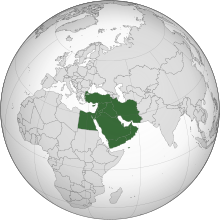Middle East


The Middle East is a large area of land in the eastern hemisphere. The lands of the Arabian Peninsula and some of the lands of the eastern Mediterranean are part of the Middle East. The Middle East's population is mostly Muslim. The name of the Middle East comes from its position to the east of Europe and to the west of the Far East.[1]
It is normal for the modern countries of Arabia (Saudi Arabia, Oman, Yemen, Bahrain, Jordan, Kuwait, and the United Arab Emirates) to be counted with the modern countries of Iraq, Syria, Lebanon, Cyprus, and Palestine (the State of Palestine and Israel) as part of the Middle East.[1]
The name "Middle East" does not always have the same meaning, and the size of the area is not always the same.[1] When the name Middle East started to be common, it was the name for the lands in between the Near East and the Far East. The Indian subcontinent was part of the Middle East at that time.[2] Now, parts of south-west Asia and northern Africa can count as the Middle East. The land between Egypt and Iran is a common definition.[2] Many countries in the Middle East today are also part of the Near East.[1] Sometimes, people name countries that are far away from these countries as countries in the Middle East. These countries can be in North Africa (like Morocco) and the Indian subcontinent (like Pakistan).[1] This area also has the name Greater Middle East.
Many ancient civilizations began in the Fertile Crescent in the Middle East. These were Sumer, Babylonia and Assyria in the area called Mesopotamia. The Abrahamic religions that believe in one God also started in the Middle East. (Judaism and Christianity began in ancient Palestine and Islam began in Arabia.) Today, the Middle East is the homeland of Arabs, Turks, Persians, Kurds, and Jews, among many other ethnic groups. Islam is the most common religion in the Middle East. Islam came to most of the Middle East's lands in the 7th century AD, during the first Muslim conquests of the Sasanian Empire and parts of the Byzantine Empire.
Today, the Middle East is very important because much of the petroleum that other countries use comes from here. There are also many arguments and wars, such as the conflict between Sunni and Shia, the Israeli–Palestinian conflict, and the Syrian civil war.
Countries
[change | change source]Full sovereign countries
[change | change source]Partially recognized countries / territories
[change | change source]Related pages
[change | change source]References
[change | change source]- ↑ 1.0 1.1 1.2 1.3 1.4 Everett-Heath, John (2020). "Middle East, The". Concise Oxford Dictionary of World Place Names (6th ed.). Oxford University Press. doi:10.1093/acref/9780191905636.001.0001. ISBN 978-0-19-190563-6.
- ↑ 2.0 2.1 "Middle East, n.". Oxford English Dictionary Online (3rd ed.). Oxford University Press. 2020 [2002].
